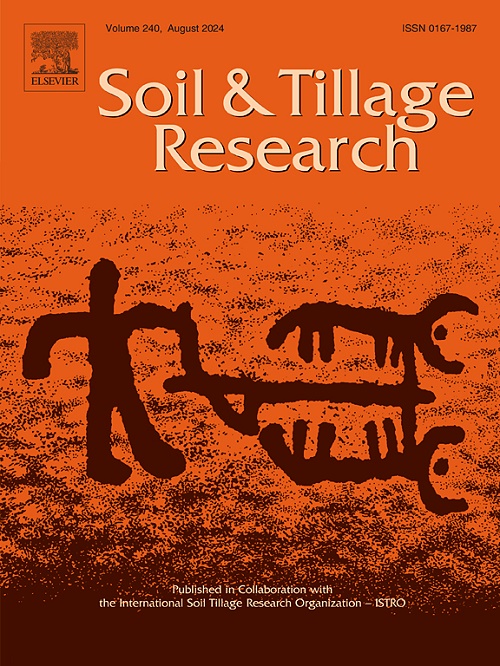施肥对颗粒和矿物相关有机碳积累和稳定的meta分析
IF 6.1
1区 农林科学
Q1 SOIL SCIENCE
引用次数: 0
摘要
施肥是影响土壤有机碳积累的关键因素。施肥策略对有机碳固存的影响已被广泛研究,但其对矿物相关有机碳(MAOC)和颗粒有机碳(POC)积累及其全球分布格局的影响尚不清楚。我们对870个观测数据进行了荟萃分析,以评估施肥对土壤C组分及其稳定性的影响,并确定主要驱动因素。施肥可使土壤中MAOC和POC含量分别提高18 %和68 %,MAOC / SOC比值降低10 %。有机肥和矿肥配施对毛酸盐(MAOC)和POC (POC)含量的提高最为显著,分别为30 %和125 %。低碳氮比、低粘粒含量、高pH值(≥7.3)、施肥时间超过10年的干旱区有机碳库显著增加。施肥土壤有机质中烷基C、羰基C和羧基C的增加和o -烷基C的减少表明分子结构向更稳定的方向转变,反映了土壤有机碳稳定性的提高。与低纬度地区相比,中纬度至高纬度地区土壤有机碳对施肥的响应增强。综上所述,施肥条件下土壤有机碳积累主要由POC增加和有机碳分子结构稳定性提高驱动;这为理解农业管理下的土壤固碳提供了重要的见解。本文章由计算机程序翻译,如有差异,请以英文原文为准。
Meta-analysis of the accumulation and stabilisation of particulate and mineral-associated organic carbon by fertilization
Fertilization is a crucial factor influencing soil organic carbon (SOC) accumulation. While the effects of fertilization strategies on SOC sequestration have frequently been investigated, their impacts on mineral-associated organic carbon (MAOC) and particulate organic carbon (POC) accumulation and their global distribution patterns remain unclear. We conducted a meta-analysis of 870 observations to assess the effects of fertilization on soil C fractions and their stability and identify the main drivers. Fertilization increased MAOC and POC contents by 18 % and 68 %, respectively, while reducing the ratio of MAOC to SOC by 10 %. Co-application of mineral and organic fertilisers led to the most significant increases in MAOC (30 %) and POC (125 %) contents. Significant increases in SOC pools occurred in arid regions with low soil C/N ratio, low clay content, high soil pH (≥7.3), and fertilization duration exceeding 10 years. The increase in alkyl C, carbonyl C, and carboxyl C and a decrease in O-alkyl C in soil organic matter under fertilization indicate a shift toward more stable molecular structures, reflecting the increased SOC stability. SOC responses to fertilization were enhanced in mid-latitude to high-latitude regions compared to lower latitudes. In conclusion, under fertilization, SOC accumulation is primarily driven by POC increases and greater molecular structural stability of SOC; this offers crucial insights for understanding soil carbon sequestration under agricultural management.
求助全文
通过发布文献求助,成功后即可免费获取论文全文。
去求助
来源期刊

Soil & Tillage Research
农林科学-土壤科学
CiteScore
13.00
自引率
6.20%
发文量
266
审稿时长
5 months
期刊介绍:
Soil & Tillage Research examines the physical, chemical and biological changes in the soil caused by tillage and field traffic. Manuscripts will be considered on aspects of soil science, physics, technology, mechanization and applied engineering for a sustainable balance among productivity, environmental quality and profitability. The following are examples of suitable topics within the scope of the journal of Soil and Tillage Research:
The agricultural and biosystems engineering associated with tillage (including no-tillage, reduced-tillage and direct drilling), irrigation and drainage, crops and crop rotations, fertilization, rehabilitation of mine spoils and processes used to modify soils. Soil change effects on establishment and yield of crops, growth of plants and roots, structure and erosion of soil, cycling of carbon and nutrients, greenhouse gas emissions, leaching, runoff and other processes that affect environmental quality. Characterization or modeling of tillage and field traffic responses, soil, climate, or topographic effects, soil deformation processes, tillage tools, traction devices, energy requirements, economics, surface and subsurface water quality effects, tillage effects on weed, pest and disease control, and their interactions.
 求助内容:
求助内容: 应助结果提醒方式:
应助结果提醒方式:


